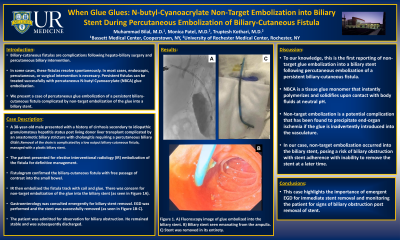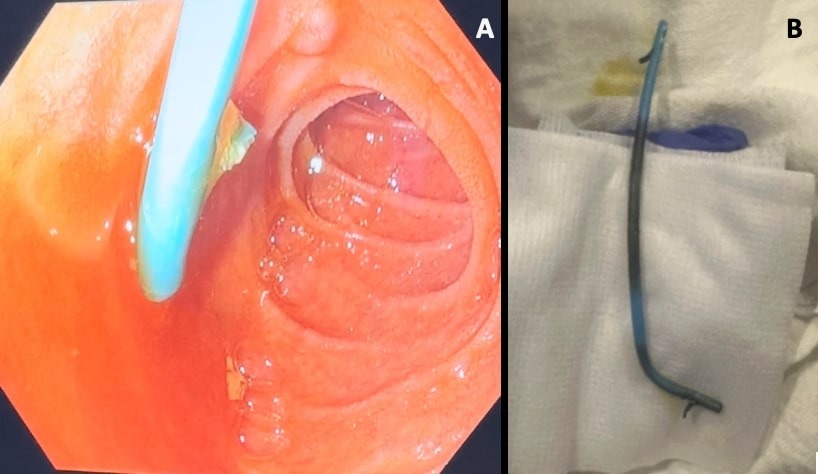Monday Poster Session
Category: Biliary/Pancreas
P1817 - When Glue Glues: N-butyl-Cyanoacrylate Non-Target Embolization into Biliary Stent During Percutaneous Embolization of Biliary-Cutaneous Fistula
Monday, October 28, 2024
10:30 AM - 4:00 PM ET
Location: Exhibit Hall E

Has Audio

Muhammad Bilal, MD
Bassett Medical Center
Cooperstown, NY
Presenting Author(s)
Muhammad Bilal, MD1, Monica Patel, MD2, Truptesh Kothari, MD2
1Bassett Medical Center, Cooperstown, NY; 2University of Rochester Medical Center, Rochester, NY
Introduction: Biliary-cutaneous fistulas, while uncommon, are complications following hepato-biliary surgery and percutaneous biliary intervention. In some cases, these fistulas resolve spontaneously. In most cases, endoscopic, percutaneous, or surgical intervention is necessary. Persistent fistulas can be treated successfully with percutaneous N-butyl Cyanoacrylate (NBCA) glue embolization. We present a case of percutaneous glue embolization of a persistent biliary-cutaneous fistula complicated by non-target embolization of the glue into a biliary stent.
Case Description/Methods: A 38-year-old male has a history of cirrhosis secondary to idiopathic granulomatous hepatitis status post living donor liver transplant complicated by an anastomotic biliary stricture with cholangitis requiring a percutaneous biliary drain. Removal of the drain is complicated by a low output biliary-cutaneous fistula, which is managed with a plastic biliary stent. The patient presented for elective interventional radiology (IR) embolization of the fistula for definitive management.
Fistulogram confirmed the biliary-cutaneous fistula with free passage of contrast into the small bowel. IR then embolized the fistula track with coil and glue. There was concern for non-target embolization of the glue into the biliary stent. Gastroenterology was consulted emergently for biliary stent removal. EGD revealed biliary stent with traces of glue emanating from the ampulla (Figure 1A). The stent was retrieved with a snare and removed (Figure 1B).
The patient was admitted for observation for biliary obstruction. The following day he remained asymptomatic with total bilirubin 0.7 mg/dL. He was subsequently discharged home.
Discussion: To our knowledge, this is the first reporting of non-target glue embolization into a biliary stent following percutaneous embolization of a persistent biliary-cutaneous fistula. NBCA is a tissue glue monomer that instantly polymerizes and solidifies upon contact with body fluids at neutral pH. Non-target embolization is a potential complication that has been found to precipitate end-organ ischemia if the glue is inadvertently introduced into the vasculature. In our case, non-target embolization occurred into the biliary stent, posing a risk of biliary obstruction with stent adherence with inability to remove the stent at a later time. This case highlights the importance of emergent EGD for immediate stent removal and monitoring the patient for signs of biliary obstruction in this situation.

Disclosures:
Muhammad Bilal, MD1, Monica Patel, MD2, Truptesh Kothari, MD2. P1817 - When Glue Glues: N-butyl-Cyanoacrylate Non-Target Embolization into Biliary Stent During Percutaneous Embolization of Biliary-Cutaneous Fistula, ACG 2024 Annual Scientific Meeting Abstracts. Philadelphia, PA: American College of Gastroenterology.
1Bassett Medical Center, Cooperstown, NY; 2University of Rochester Medical Center, Rochester, NY
Introduction: Biliary-cutaneous fistulas, while uncommon, are complications following hepato-biliary surgery and percutaneous biliary intervention. In some cases, these fistulas resolve spontaneously. In most cases, endoscopic, percutaneous, or surgical intervention is necessary. Persistent fistulas can be treated successfully with percutaneous N-butyl Cyanoacrylate (NBCA) glue embolization. We present a case of percutaneous glue embolization of a persistent biliary-cutaneous fistula complicated by non-target embolization of the glue into a biliary stent.
Case Description/Methods: A 38-year-old male has a history of cirrhosis secondary to idiopathic granulomatous hepatitis status post living donor liver transplant complicated by an anastomotic biliary stricture with cholangitis requiring a percutaneous biliary drain. Removal of the drain is complicated by a low output biliary-cutaneous fistula, which is managed with a plastic biliary stent. The patient presented for elective interventional radiology (IR) embolization of the fistula for definitive management.
Fistulogram confirmed the biliary-cutaneous fistula with free passage of contrast into the small bowel. IR then embolized the fistula track with coil and glue. There was concern for non-target embolization of the glue into the biliary stent. Gastroenterology was consulted emergently for biliary stent removal. EGD revealed biliary stent with traces of glue emanating from the ampulla (Figure 1A). The stent was retrieved with a snare and removed (Figure 1B).
The patient was admitted for observation for biliary obstruction. The following day he remained asymptomatic with total bilirubin 0.7 mg/dL. He was subsequently discharged home.
Discussion: To our knowledge, this is the first reporting of non-target glue embolization into a biliary stent following percutaneous embolization of a persistent biliary-cutaneous fistula. NBCA is a tissue glue monomer that instantly polymerizes and solidifies upon contact with body fluids at neutral pH. Non-target embolization is a potential complication that has been found to precipitate end-organ ischemia if the glue is inadvertently introduced into the vasculature. In our case, non-target embolization occurred into the biliary stent, posing a risk of biliary obstruction with stent adherence with inability to remove the stent at a later time. This case highlights the importance of emergent EGD for immediate stent removal and monitoring the patient for signs of biliary obstruction in this situation.

Figure: Figure 1. A) Biliary stent seen emanating from the ampulla. B) Stent was removed in its entirety.
Disclosures:
Muhammad Bilal indicated no relevant financial relationships.
Monica Patel indicated no relevant financial relationships.
Truptesh Kothari indicated no relevant financial relationships.
Muhammad Bilal, MD1, Monica Patel, MD2, Truptesh Kothari, MD2. P1817 - When Glue Glues: N-butyl-Cyanoacrylate Non-Target Embolization into Biliary Stent During Percutaneous Embolization of Biliary-Cutaneous Fistula, ACG 2024 Annual Scientific Meeting Abstracts. Philadelphia, PA: American College of Gastroenterology.
